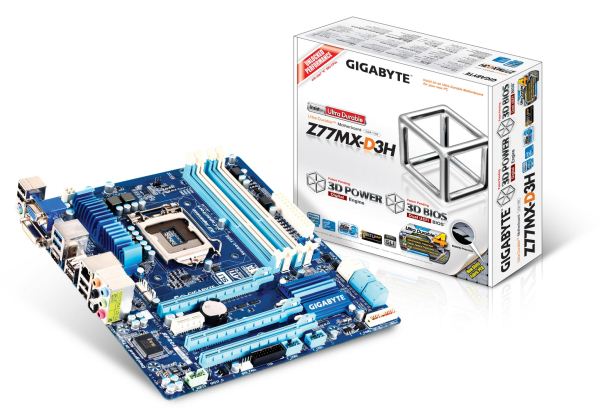Gigabyte GA-Z77MX-D3H Review – Z77 and MicroATX
by Ian Cutress on May 24, 2012 3:00 PM EST- Posted in
- Motherboards
- Gigabyte
- Z77
Z77 motherboards are currently spanning a wide range of prices - as low as $80 after rebate and up above $300 if you want a board with everything. Today we have looked at the Gigabyte Z77MX-UD3H, a microATX board hoping to make waves at the $135 price point.
Gigabyte is continuing their trend of supplying a factory overclock to the processors used in this board. Should your processor utilize turbo modes to boost the single threaded throughput, the Z77MX-D3H will tell the processor to utilize its top turbo mode even in multithreaded scenarios. This invariably leads to greater performance at stock in these scenarios, at the expense of power draw. I also had no issues with running my DDR3-2400 9-11-11 G.Skill RipjawsX in this board, which can sometimes present problems in other boards.
Therefore, for our $135, we get a top performing board in all things dealing with processor throughput. In terms of features, as we are dealing with a smaller microATX board at the low end of the price bracket, we would assume a distinct lack of add-ons. However, Gigabyte has decided to still keep dual GPU SLI/Crossfire compatibility on board, with the possibility of three-way GPU if a user decides to add in a third single slot graphics cards together (and the third card being PCIe 2.0 x4 speed). This opens up possibilities of using this board in a dual-card SLI+PhysX layout.
Elsewhere on the board, we have a strange selection of NIC/Audio compared to almost every other non-Gigabyte motherboard on the market, as the Z77MX-D3H uses an Atheros NIC and Via VT2021 audio. The NIC selection might be understandable - as the high end Gigabyte boards use Killer NICs made by Atheros, Gigabyte probably have a deal for Atheros to also supply network controllers for the rest of the Gigabyte range.
Negative points are seemingly few - the aesthetics of the board are not much to look at, the software could use a large amount of redecorating and upgrading, the BIOS isn't exactly the most stable if you are overclocking and I'm rather suspicious with the integrated software layer fixing the voltage output value in the operating system. The fan controls are relatively basic as well, with other manufacturers investing heavily in fan control. We do not get a lot in the box, but this board is built to meet as low a price point as possible whilst still giving reasonable profit margins. I would have still liked to see perhaps a mini-PCIe slot on board with a WiFi card, or another couple of SATA ports to push this board to the next level.
The Z77MX-D3H does represent a good board for its size and price point. Nothing would stop this board being a small powerhouse underpinning an Ivy Bridge build. There are a few fundamental issues that need updating (software, fan controls) before I could give this motherboard an award, but I would gladly recommend it to friends and family as part of a good mATX Ivy system.











25 Comments
View All Comments
SixOfSeven - Friday, May 25, 2012 - link
Great review, great board. However:Case Open Test Bed - CoolerMaster Lab V1.0
There are a few microATX chassis worth considering but it's still pretty slim pickings out there.
kenyee - Friday, May 25, 2012 - link
Probably something that would be worth mentioning, but they've figured out how to set up the DSDT tables in the UEFI BIOS better than other motherboard makers if you're trying to set up a Hackintosh...MadAd - Sunday, May 27, 2012 - link
Thanks for the review of a more 'normal' board instead of these 4x16 pcie monsters - not all of us have multiple graphics cards (mines full of disks) and simply dont need more than a uATX but do still want good overclocking, sata 6 and the best bolt onsStefanM - Sunday, May 27, 2012 - link
Excellent review,I have this board paired to a i5-3570K under a thermalright venomous X and 16GBs of corsair XMS3 DDR3-1600 RAM.
I'm @ 4.4GHz, LLC extreme, 44x, stock voltage (1.2v) and DDR3-1600... the board refuses to complete POST if I raise the BCLK over 101 and the multiplier above 44x despite voltage increases to the ram/cpu - I'm also using the F11 Bios.
najames - Monday, June 4, 2012 - link
Does this board have the ability to enable VT-d for vurtualization? It would also be nice to have a normal sized PSU and test power on an on-CPU Intel graphics system.